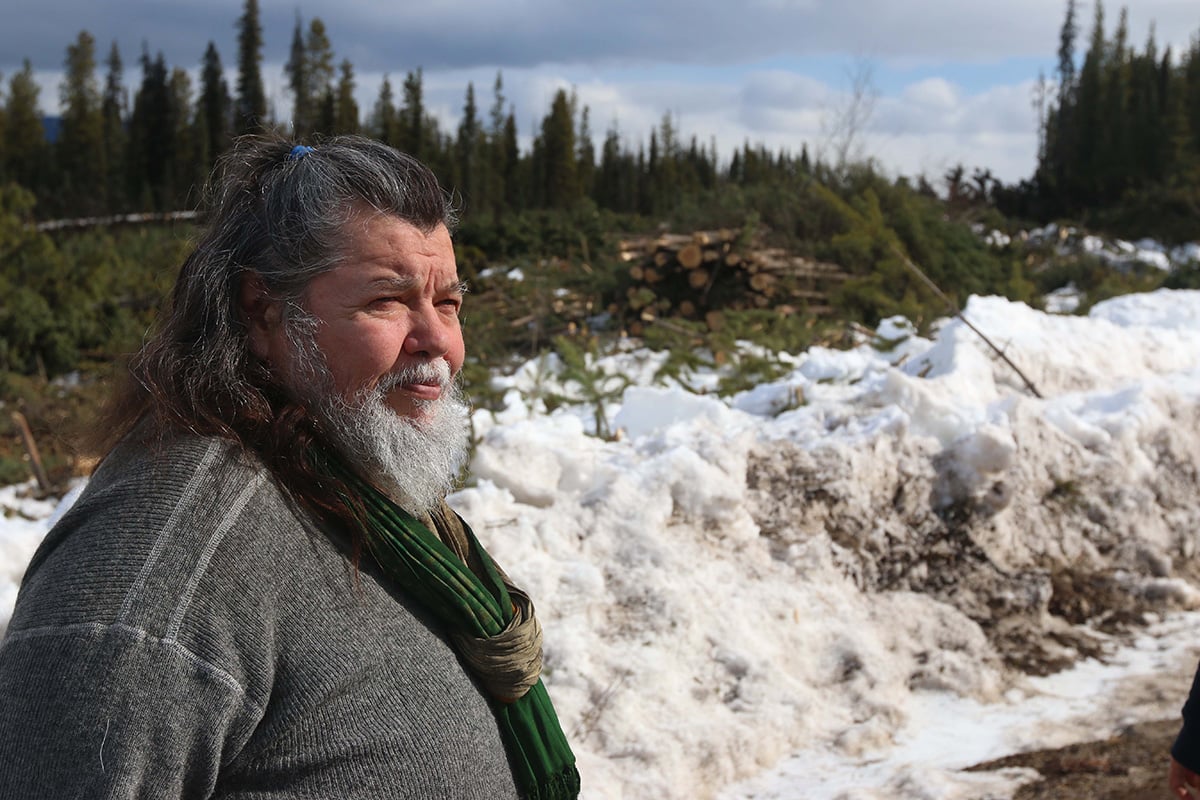Chief Dsta’hyl is often jovial — even while attempting to seize the trucks and equipment of a pipeline company building a route through his clan’s territory.
In videos posted to social media last week, he banters with pipeline workers as he removes batteries from the machinery (10 in total, based on one video), while explaining that he’s confiscating the equipment to force the company, Coastal GasLink, to meet with the clan.
Last week, Dsta’hyl was arrested and charged with theft over $5,000 for his part in decommissioning the equipment. He spent one night in jail as lawyers hammered out the terms of his release, which came with restrictions on his return to the territory.
But despite the conflict that erupted over the past week on Likhts’amisyu territory — a clan of the Wet’suwet’en Nation — Dsta’hyl has mostly positive things to say about the workers. Though occasionally racist or aggressive, they are largely friendly and helpful when he’s on the territory monitoring pipeline construction for the clan, he said.
“CGL workers, most of them are great,” Dsta’hyl says from his home in Witset, a Wet’suwet’en community west of Smithers, where he woke up in his own bed for the first time in almost a week after time on the frontlines and at the Houston RCMP detachment.
“A lot of the workers, they were going by smiling and thumbs up and all this.”
Dsta’hyl, whose English name is Adam Gagnon, is Likhts’amisyu Clan’s chosen representative as senior enforcement officer monitoring pipeline construction on the territory.
According to statements from RCMP and Coastal GasLink, he was among a group of protesters that blocked access to a work camp about 100 kilometres southwest of Houston, B.C., last week, resulting in two arrests.
Dsta’hyl sees it differently. He and another Likhts’amisyu Chief, Tsebesa, were attempting to monitor pipeline work on the territory when Coastal GasLink workers denied them access.
“They were stalling us, stalling us, because they had CGL’s security escorting us,” Dsta’hyl says.
Eventually, over the security officer’s radio, he heard a call from another Coastal GasLink employee: “OK, bring ’em in,” it said. “We’ve got the blockade up.” The plan, Dsta’hyl surmised, was to keep the Chiefs from the actual construction sites.
“So, they were blockading all of the hereditary Chiefs off of their own territory,” he says. “Once they did that, I basically said, ‘We’re not going to go anywhere. We’re going to stay right here for as long as it takes for you to let us in.’”
The standoff between Likhts’amisyu Chiefs and Coastal GasLink employees had been building for weeks. Or years, if you count the on-the-ground resistance to pipelines throughout Wet’suwet’en territory.
It began more than a decade ago at the site of what is now the Unist’ot’en Healing Centre, about 30 kilometres from where Dsta’hyl was arrested. That’s when the Unist’ot’en house group (which is part of Gilseyhu Clan) gated the Morice West Forest Service Road, blocking access to a portion of Coastal GasLink’s 670-kilometre pipeline route that is to carry fracked gas from northeast B.C. to the LNG Canada plant in Kitimat.
Two years ago, the frontline moved east, into the territory of the Gidimt’en Clan, which shares a boundary with Unist’ot’en. The Gidimt’en moved to support the resistance with a second encampment and roadblock. Arrests were made on Gidimt’en territory in January 2019, leading to the opening of the Unist’ot’en gate.
It closed again, only briefly, a year later, as dozens of arrests were made at several locations along the Morice early in 2020.
In recent weeks, it’s the Likhts’amisyu Clan that has been facing off against the company.
The clan has territories that flank Gidimt’en to the east and Unist’ot’en to the west. In the eastern portion of Likhts’amisyu territory, clan members have been building a camp at Parrot Lake, a traditional village site until its residents were removed by Indian Agents and RCMP more than a century ago, Dsta’hyl says.
The site is within one kilometre of the pipeline route. Dsta’hyl said work there ceased after he asked them to leave two weeks ago.
“I warned them, at Parrot Lake, I said I was going to be seizing one asset a day until they were off our territory,” he said. But work continued on another Likhts’amisyu Clan territory, he said, so he continued to seize company equipment.
In an email to The Tyee, Coastal GasLink denied that work had stopped near Parrot Lake or anywhere on this section of its pipeline route, with the exception of plans to drill under the Morice River. Those were halted when a camp was established at the drill site on Gidimt’en territory in September.
When Dsta’hyl and Chief Tsebesa were denied access to the territory on Oct. 24, they set up camp. After security left that night, they went in to investigate and discovered heavy machinery had been parked across the road, blocking access at multiple locations.
“We just went right in and we found that they had construction going full force, 24 hours a day, over by the man camp. That was a game changer right there,” he says.
Chief Tsebesa was “just beyond herself,” he said. “She was in tears.... They just could not believe how destructive this pipeline is. The degradation of our land is just beyond belief.”
In a statement posted to Coastal GasLink’s website, the company blames pipeline opponents for putting “people, property and the environment at risk” during the recent dispute.
“On Oct. 24, 2021, a group of opponents confronted our crews on an active construction site,” the statement says. “This group arrived unannounced and was not permitted access to the site due to safety concerns. Our crews offered to facilitate access at another time when it could be made safe to do so.
“Subsequently, crew vehicles were blocked in both directions and prevented from exiting; our people subsequently departed the area, and one vehicle was able to pass through.”
RCMP and Coastal GasLink both say that essential supplies were prevented from reaching the camp, creating a safety concern.
That wasn’t the case, Dsta’hyl counters.
“We had an agreement that we were going to let the water trucks in, the sewer pump trucks, and food in,” he says. “Then CGL, when I said the condition is that I’m going to have to escort them in, they turned the trucks around. They want nothing to do with me going inside.”
He adds that he wasn’t stopping workers.
Instead, he focused on CGL equipment, “seizing assets” by removing batteries from the machinery. The goal was to force the company to deal directly with the clan, he says.
“I was really forthright with the RCMP about my intentions,” he says. “[Coastal GasLink] is dealing with the RCMP, but they won’t deal with us. They won’t talk to us.... Everybody I saw out on our territory, they’re all contractors, and that gives them complete deniability for anything that goes wrong out there.”
Concerns over damage to the territory aren’t unfounded.
Twice over the past year, Coastal GasLink has been warned by the BC Environmental Assessment Office about damage to watersheds as a result of pipeline construction, including the threat of administrative penalties that could cost the company millions of dollars.
It has also been warned about blocking access to Wet’suwet’en members tasked with monitoring pipeline construction, something the Environmental Assessment Office determined was “consistent with and a component of traditional use” in an inspection report issued this summer.
Coastal GasLink says that while it is required to maintain existing access routes, such as roads, it is able to restrict access to the pipeline right-of-way. It also referenced its recent warning from the Environmental Assessment Office as evidence that it can restrict access for safety reasons.
“In some instances, it may be necessary for CGL security to situate access control at locations that are outside of active work areas because locations do not exist for persons using existing public roads to turn around,” the report reads. “However, these locations should be as close as practicable to the active work site.”
In an email to The Tyee, RCMP said that access to the work camp was already blocked when Coastal GasLink positioned equipment outside the compound “to prevent further damage to their camp and property.”
“The only area not accessible was the work camp itself,” Cpl. Madonna Saunderson said. “Despite initial agreements and assurances to allow essential services into the camp, a further condition was added that the vehicles and contents being taken to camp be inspected from inside the compound.
“Given the history over the previous week, CGL feared that there would be further damage to the equipment and individuals may lay claim to vehicles and equipment and perhaps secure themselves into the work camp compound.”
In its statement, Coastal GasLink describes its pipeline construction as “lawful, authorized, fully permitted” and with “unprecedented support of local and Indigenous communities and agreements in place with all 20 elected First Nation councils across the 670-kilometre route,” including Wet’suwet’en communities.
Both the company and the province have repeatedly pointed to benefits agreements signed with First Nations band councils along the pipeline route as evidence of project support.
But while band councils, created under the Indian Act, govern reserves, they do not have jurisdiction over traditional territories, which are under authority of hereditary governance systems. The Coastal GasLink pipeline does not pass through any Wet’suwet’en reserves, and the nation’s hereditary leadership has maintained it was never properly consulted on the project.
On Friday, his first day back home, Dsta’hyl was busy taking calls and figuring out who will carry on the clan’s work monitoring the pipeline. He hoped that his lawyer could have the conditions waived that limit his return to the territory to activities like hunting and trapping.
But his spirits remained high. As he was released from police custody the evening before, Dsta’hyl lamented the breakdown in communication between himself and Coastal GasLink workers.
“They are silly that they didn’t just work with me,” he said. “I’m a lot more passive than the ones that may come.”
He says the words were “just a feeling” he had in the moment.
“Because, you know, people are feeling strong now,” he says. “They’re feeling their power.” ![]()
Read more: Indigenous, Rights + Justice
















Tyee Commenting Guidelines
Comments that violate guidelines risk being deleted, and violations may result in a temporary or permanent user ban. Maintain the spirit of good conversation to stay in the discussion.
*Please note The Tyee is not a forum for spreading misinformation about COVID-19, denying its existence or minimizing its risk to public health.
Do:
Do not: